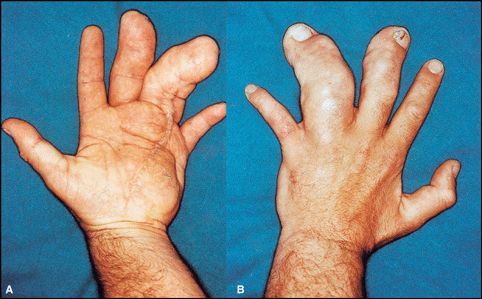Unusual Syndrome Of The Week: Macrodactyly
Macrodactyly is an uncommon anomaly of the extremities. It can affect both the fingers or toes which become abnormally large due to overgrowth of the tissues composing the digit. All the tissues are involved: bone and soft tissue-particularly the nerves, fat and skin. (photo credit)
Other names used for macrodactyly include megalodactyly, overgrowth, gigantism, localized hypertrophy, or macrodactylia fibrolipomatosis.
Hands are more commonly involved than feet. Most of the time (~90%) patients present with unilateral (one side affected) macrodactyly. Often more than one digit is involved. The most frequently involved digits of the hand are the index finger, followed by the long finger, thumb, ring, and little fingers. Syndactyly may be present in 10% of patients. Men are more often affected than women.
It is not known why macrodactyly occurs. It does not appear to be an inherited anomaly, but there are some syndromes (ie Proteus Syndrome, Maffuci syndrome, and tuberous sclerosis) which may be associated with enlarged digits. There are some surgeons who believe that macrodactyly is a variant of neurofibromatosis.
Macrodactyly may be either static or progressive. The progressive type is more common than the static.
-
In static the enlarged digit (finger or toe) is present at birth and continues to grow at the same rate as the normal digits of the hand. The involved digits are generally about 1.5 times the normal length and width of the normal digits.
-
In progressive the affected digits begin to grow soon after birth and continue growing faster than the rest of the hand. The involved digit or digits can become enormous.
There is no medical treatment for this disorder. It is treated by surgery. In the hand, the indications for surgery can often be cosmetic in nature as the hand can functionally tolerate a digit with some increased width and length. In the foot, the enlarged digit can make shoe fitting/wearing difficult.
Surgical treatment of macrodactyly is complex as multiple tissue layers are involved. It typically will involve debulking, epiphyseal arrest, and shortening. Multiple surgeries are the norm.
Soft tissue debulking:
-
This is done to help correct the width of the digit. This is often done at the same time as the epiphyseal arrest. The affected fingers are approached volarly with Bruner-type incisions/flaps. The fat is removed from the skin and the tissues are debulked.
-
Care is taken to preserve the ulnar and radial digital neurovascular bundles. Sometimes the enlarged nerve branches will need to be sacrificed along with the enlarged subcutaneous tissues.
-
When a sufficient amount of tissue has been removed, the skin flaps are overlapped and excised, which allows for tension-free closure. It needed, skin grafts using healthy skin will be done.
-
Debulking is often need to be done in staged procedures.
Shortening procedures:
-
This is done to help correct the length of the digit. Shortening procedures usually involve either surgical excision (removal) of one of the phalanges of the finger or toe, or removal of a metacarpal (hand bone) or metatarsal (foot bone).
-
Barsky and Tsuge originally introduced the two most described methods. Barsky’s technique involves removing the distal portion of the middle phalanx and proximal portion of the distal phalanx, thereby reducing the length of the finger while preserving the nail. Tsuge’s technique also preserves the nail by overlapping the dorsal portion of the distal phalanx with the volar portion of the middle phalanx.
Ray resection:
-
This may be done in progressive macrodactyly. It involved the complete removal of the digit or digits. It is also an option if there is excessive widening of the forefoot, where digital shortening and debulking procedure may not be effective.
Epiphyseal Arrest:
-
The timing of the this surgery is critical. An attempt to “guess” the adult finger length is done by comparing the child’s digits with those of his/her parents. When growth of the affected digits matches those of the parent, epiphyseal arrest can be performed. This in effect will stop the bone growth of the digit.
-
The epiphyses of the proximal and distal phalanges are the ones treated by disruption or removal. The middle phalanx epiphyses is not treated to help preserve motion at the proximal interphalangeal joint.
Other surgical options include amputation and wedge osteotomies. Amputation is reserved for patients with nonfunctioning digits or digits that are extremely difficult to correct. Wedge osteotomies are performed in patients who have digits that are grossly deviated.
Complications of macrodactyly surgery include poor healing of flaps secondary to devascularization or undue tension, nerve injury or decreased sensation, infection, stiffness, bony nonunion or malunion, and failure of the epiphysiodesis.
REFERENCES
Wood VE. Macrodactyly. In: Green DP, Hotchkiss RN, eds. Operative Hand Surgery. 4th ed. New York, NY: Churchill Livingston; 1998:533-544.
Treatment of macrodactyly; Plast Reconstr Surg. 1967; 39:590-599; Tsuge K.
Congenital anomalies of the hand; Cohen M, ed. Mastery of Plastic and Reconstructive Surgery. New York, NY: Little, Brown and Company; 1994; Upton J, Hergrueter C.
Macrodactyly; Boston Children’s Hospital website
Macrodactyly; Wheeless’ Textbook of Orthopaedics
*This blog post was originally published at Suture for a Living*












